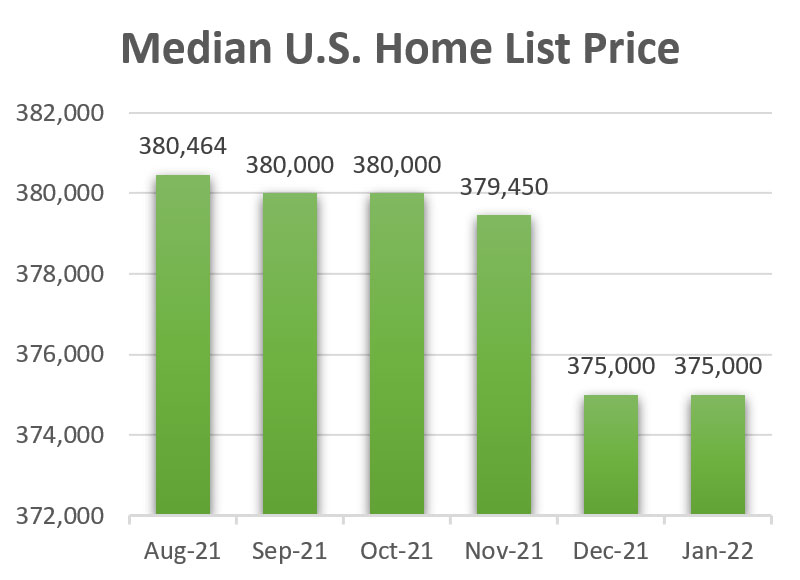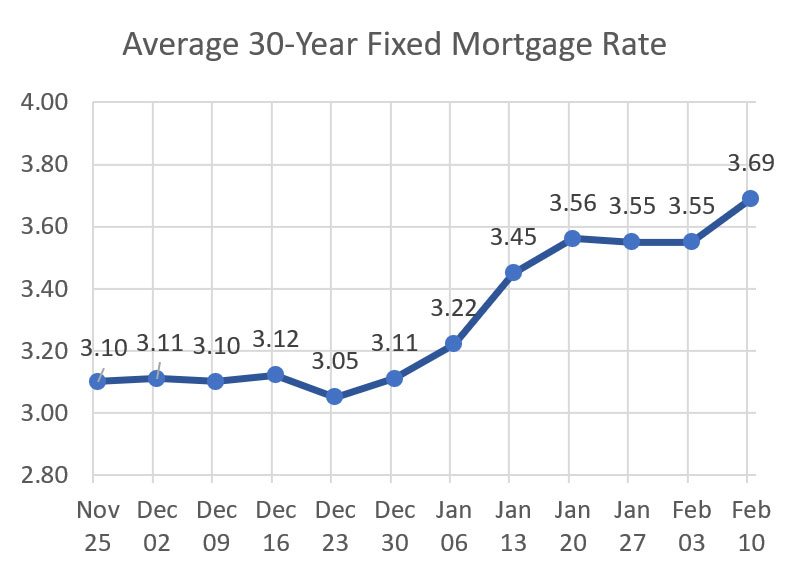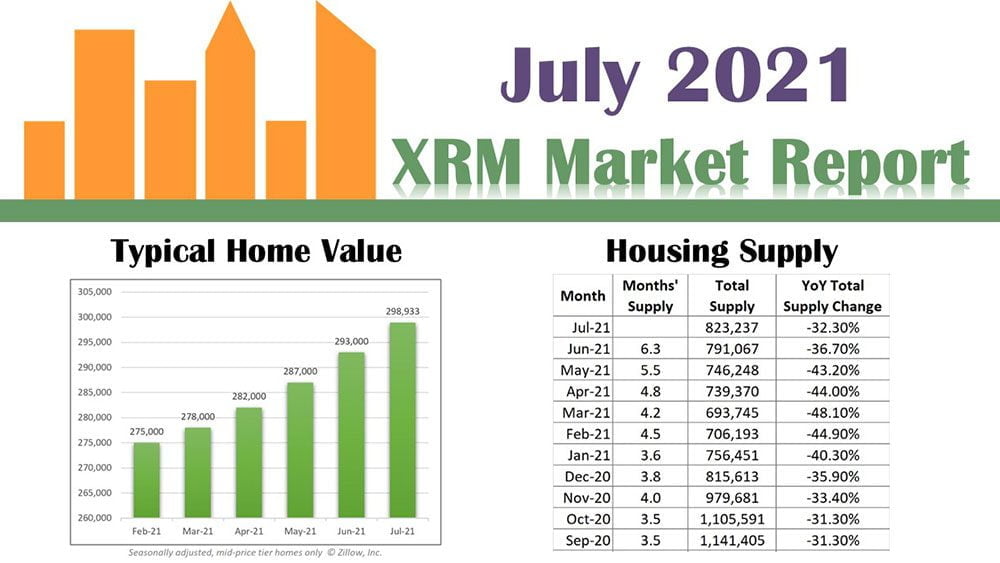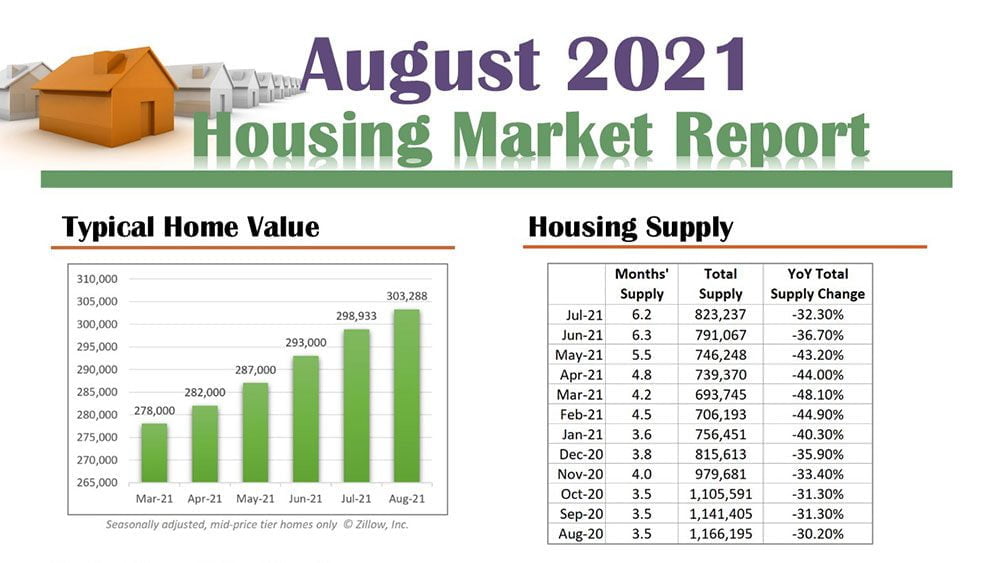Nationally, the number of homes listed in January was 326,312, down an average of 9.1% compared to January 2021. However, homes continue to sell at a rapid pace. The typical home spent 61 days on the market in January, ten days less than in January 2021, and more quickly than any January going back to 2017.
Realtor.com reports the outlook for home price growth and low inventory levels will likely continue for several months into 2022.11
Home Median List Price Remains Flat 4
- According to Realtor.com, the median list price of homes for sale in January was $375,000, the same as in December.
- January’s home median price is 10.33% higher than January 2021 ($339,900) and up 25.0% compared to January 2020 ($299,900).
- Home median prices reached a high of $385,000 in June and July.

January Existing-Home Sales Declined After Increasing for Three Straight Months 1, 5, 6
- December sales of existing homes (including single-family homes, townhomes, condominiums, and cooperatives) fell 4.6% to 6.18 million units (SAAR) from the November pace of 6.48 million (revised upward), which is 7.1% below December 2020, according to the National Association of Realtors® (NAR).
- December home sales were down in all four HUD Census regions.
- Interest rates are low, but lean inventories and house price growth are constraining sales.
- Existing-home sales for all of 2021 were 8.5% higher than 2020 (6.12 million units), which is the strongest pace since 2006.
New Home Construction Increased 2
Total housing starts rose 1.4% in December to 1.70 million units (SAAR), up 2.5% from December 2020. Construction material costs and labor shortages continue to constrain homebuilding.
- Single-family housing starts declined 2.3% to 1.17 million homes (SAAR) in December from November’s pace of 1.20 million (revised upward) and were 10.9% lower than December 2020.
- New construction of single-family homes increased 13.4% in all of 2021 compared to 2020.
- Multifamily housing starts (5+ units in a structure), at 524,000 units (SAAR) in December, increased 13.7% from 461,000 units in November and were 56.0% higher than 2021.
- Multifamily homes increased 22.1% for all of 2021 compared with 2020.
- For all of 2021, total construction of new homes reached 1.595 million units, 15.6% higher than in 2020 (1.380 million units) and the strongest pace since 2006.
Year-Over-Year Home Price Increases Remained High in November 2, 7, 8
- Year-over-year home price annual gains ranged from 17.5% to 18.3% as of November.
- The Federal Housing Finance Agency (FHFA) seasonally adjusted purchase-only house price index for November estimates home values increased 1.12% from October and 17.5% year-over-year.
- The FHFA index shows that U.S. home values are 61% above the housing bubble peak set in April 2007.
Existing Homes For Sale Reached a Record Low While the Inventory of New Homes For Sale Rose 2
- The listed inventory of new homes for sale at the end of December (403,000 units) increased 1.5% from November, up 34.8% year-over-year.
- The current inventory of new homes for sale would support 6 months of sales at the current sales pace, down from November (6.6 months) because of an increase in December sales.
- Existing homes for sale reached a record low of 910,000 units in December, down 18% from November and 14.2% from December 2020 (1.06 million units).
- The current inventory of existing homes for sale represents a 1.8-month supply, also a record low, which is down from November (2.1 months).
- The long-term average for months’ supply of homes on the market is 6.0 months.
The 30-Year Fixed-Rate Mortgage (FRM) Remains Above 3% 2, 10
- The average weekly 30-year FRM for the week ending January 6 was 3.22%, up from a low in December of 3.05% the week ending December 23.
- The weekly average 30-year FRM climbed steadily in January.
- A year ago, the average weekly 30-year FRM hit a historic low of 2.65% the week of January 7, 2021.

Sources:
1 Realtor.com residential listings database
2 HUD Housing Market Indicators Monthly Update January 2022
3 New home sales are based on purchase agreement signings rather than on closings, as with existing homes.
4 Zillow United States Home Values
5 Because existing-home sales are based on a closing, December sales reflect contract signings in October and November.
6 National Association of Realtors
7 Federal Housing Finance Agency (FHFA)
8 The home price data for both indices are based on real estate sales contracts signed in late September and October, with subsequent closings during November. (Both price indices are released with a 2-month lag.)
9 Freddie Mac
10 FRED, Federal Reserve Bank of St. Louis
11 Realtor.com January 2022 Monthly Housing Market Trends Report
© 2024 xpertRealtyMarketing.



